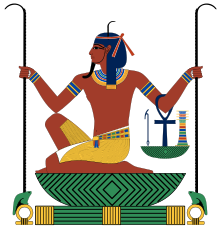
Back حح Arabic حح ARZ Heh Azerbaijani হে (দেবতা) Bengali/Bangla Heh Catalan Heh Czech Heh Danish Heh German Χε Greek Heh Esperanto
| Heh | |||
|---|---|---|---|
 An aspect of Heh, holding a pair of notched palm branches | |||
| Name in hieroglyphs |
| ||
| Major cult center | Hermopolis (as a member of the Ogdoad) | ||
| Symbol | palm branch | ||
| Consort | Hauhet (female aspect of Heh) | ||
| Part of a series on |
| Ancient Egyptian religion |
|---|
 |
|
|
Ḥeḥ (ḥḥ, also Huh, Hah, Hauh, Huah, and Hehu[citation needed]) was the personification of infinity or eternity in the Ogdoad in ancient Egyptian religion.[1] His name originally meant "flood", referring to the watery chaos Nu that the Egyptians believed existed before the creation of the world.[2] The Egyptians envisioned this chaos as infinite, in contrast with the finite created world, so Heh personified this aspect of the primordial waters.[3] Heh's female counterpart and consort was known as Hauhet, which is simply the feminine form of his name.[1]
Like the other concepts in the Ogdoad, his male form was often depicted as a frog, or a frog-headed human, and his female form as a snake or snake-headed human. The frog head symbolised fertility, creation, and regeneration, and was also possessed by the other Ogdoad males Kek, Amun, and Nun.[4] The other common representation depicts him crouching, holding a palm stem in each hand (or just one),[5] sometimes with a palm stem in his hair, as palm stems represented long life to the Egyptians, the years being represented by notches on it. Depictions of this form also had a shen ring at the base of each palm stem, which represented infinity. Depictions of Heh were also used in hieroglyphs to represent one million, which was essentially considered equivalent to infinity in Ancient Egyptian mathematics. Thus this deity is also known as the "god of millions of years".
- ^ a b Wilkinson, Richard H. (2003). The Complete Gods and Goddesses of Ancient Egypt. Thames & Hudson. p. 109
- ^ Allen, James P. Genesis in Egypt: The Philosophy of Ancient Egyptian Creation Accounts. Yale Egyptological Seminar, 1988
- ^ Allen, James P. Middle Egyptian: An Introduction to the Language and Culture of Hieroglyphs. Cambridge University Press, 2000
- ^ Rush, John (2007). The Twelve Gates: A Spiritual Passage Through the Egyptian Books of the Dead. Berkeley, CA: Frog. p. 281.
- ^ Owusu, Heike (2008). Egyptian Symbols. New York, NY: Sterling. p. 73.